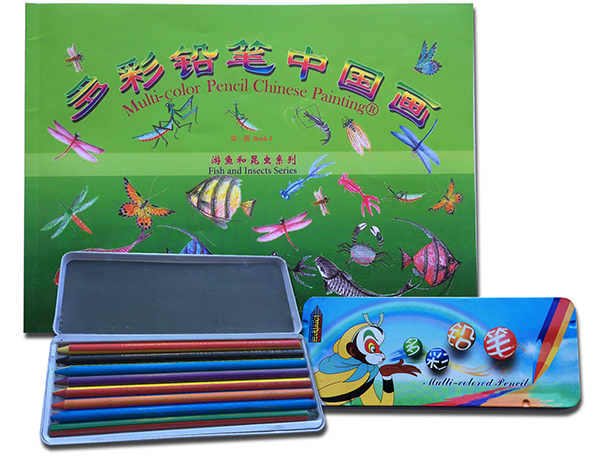
The Multi-colored Pencil is an essential tool for new learners of Chinese painting
1. Multi-color Pencil
The Multi-colored Pencil is a brand-new writing and drawing tool innovated by Mr. Arthur Liu, a famous painter, educator and inventor. The Multi-colored Pencil is patented in China (Chinese patent No. ZL 2011 2 0125765.X) while its application for a US patent is under review. Providing as many as five colors in one pencil, the product is convenient to carry and applicable for both writing and drawing. It also boasts a feature much like that of the Chinese painting brush: it can change between dark and pale, line and plane, and deep and shallow through employing center-point lining and side-coloring techniques; it can also change colors by rotating the pencil in one’s grip. As a result, one single pencil can create the colorful effect of Chinese painting, with its characteristic variations in shades. The unique painting style thus created with the new-concept multi-colored pencil invented by Arthur Liu is named as Multi-colored Pencil Chinese Painting.
2. Rainbow Words
With Multi-color Pencils, one can write words in a brilliant rainbow of various colors. As Multi-color Pencils consist of combinations of two,three and four colors. So, Multi-color Pencils produce changes with two, three or four colors from one pencil. Thus, Multi-color Pencils produce omiraculous changes. That’s why Multi-color Pencils are known as the “miracle pencils for developing pupils’ intelligence”. The words written with Multi-color Pencils invented by Arthur B Liu, a well-known painting artist, are aptly described as Rainbow Words.
3. Creating Chinese Paintings with Multi-color Pencils
We all know that learning Chinese painting poses a big challenge to beginners. Traditional Chinese painting requires them to start by learning how to hold and operate the brush—straight, slanted, along and against the brush flow. One also needs to learn such techniques as lifting, tilting, pausing, and thrusting the brush. Furthermore, one is also expected to learn the methods and techniques for using water, colors and ink, e.g., dividing ink into five shades: semi-dry, wet, thick, pale, and dry. Practice of those basic skills takes one to two years at a minimum before a student is able to grasp the techniques of traditional Chinese painting and produce some decent works.
Multi-color Pencils significantly lower the threshold for learning Chinese painting—producing faster results with half the effort required. So long as you know how to hold the pencil the usual way and slanted, you’ll be able to produce by drawing the effect found in traditional Chinese painting (see the two paintings for comparison). Multi-color Chinese Painting—a unique and brand-new painting technique and art form created with the new product invented by Mr. Arthur Bihua Liu, a famous artist.
Admittedly, Multi-color Chinese Painting is not and cannot replace traditional Chjnese painting. It provides but a shortcut for beginners to learn traditional Chinese painting and a key to this genre of art. Once you’ve learned how to create Chinese paintings with Multi-color pencils, proceeding to the painting brush won’t be a headache anymore!
4. Multi-color Pencil Chinese Painting Techniques
Essentially, there are two different ways to hold the MC Pencil when creating a Chinese painting. Just like painting with a Chinese painting brush, you can draw a line with the color tip or paint the color with the color side of the MC pencil. You can also change the color by using different sides of the MC pencil, making it possible to create the effect of different hues and colors typical of traditional Chinese paintings. That’s what is unique about the MC Pencil.
Drawing lines with the tip of the MC pencil:
By holding the pencil the way you would normally do for writing, you can draw fine lines. You can draw different colors lines by rotating the MC Pencil to get the color you need.
Painting color with the side of the MC pencil:
By holding the pencil the way you would normally do when coloring, you can produce thick colored strokes. Make sure the whole side of the MC Pencil is entirely on the paper's surface. You may also choose the color you need by rotating the MC Pencil. (You may try a few strokes on another piece of paper till the entire slanted side of the pencil is touching the paper's surface and is able to paint the thick color strokes.)





